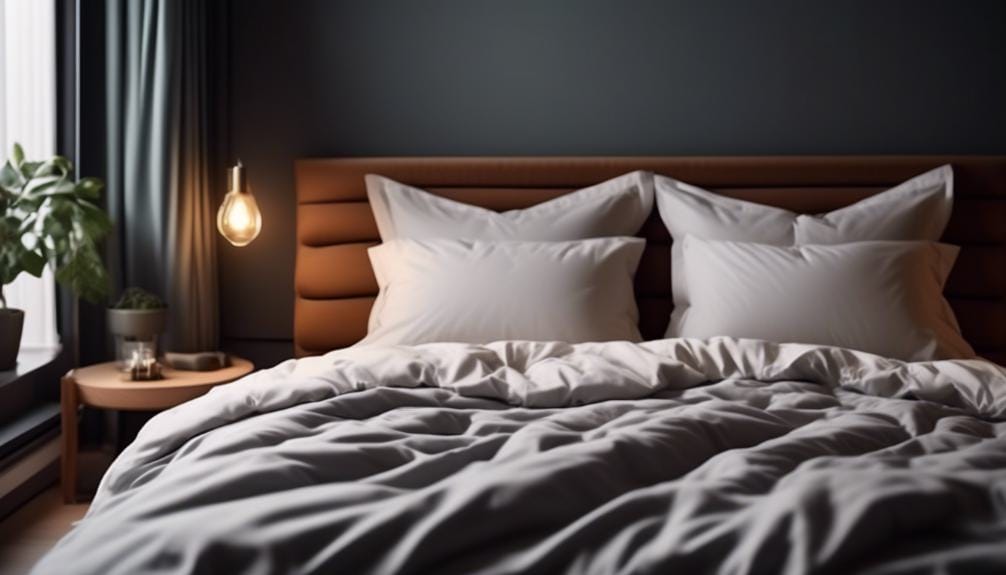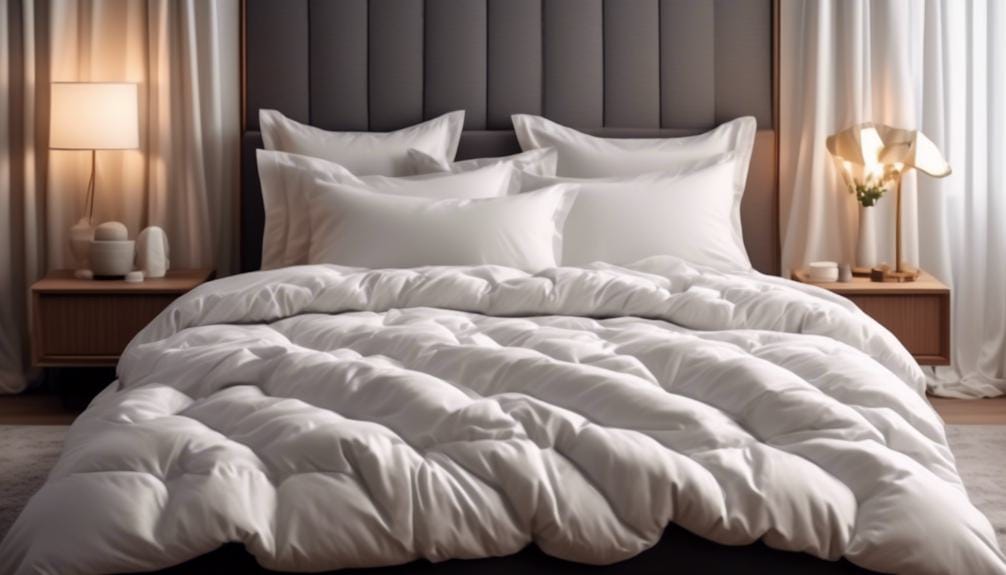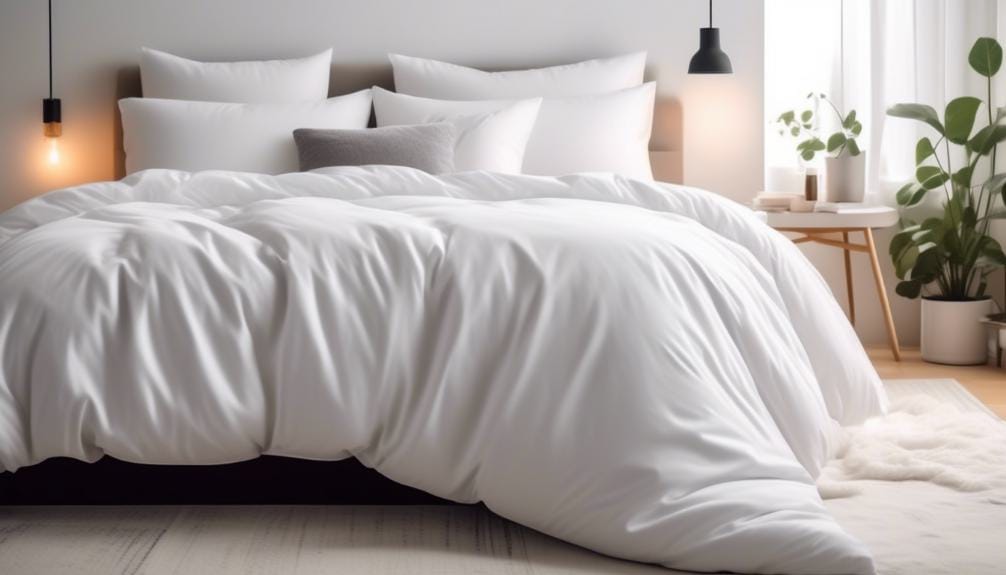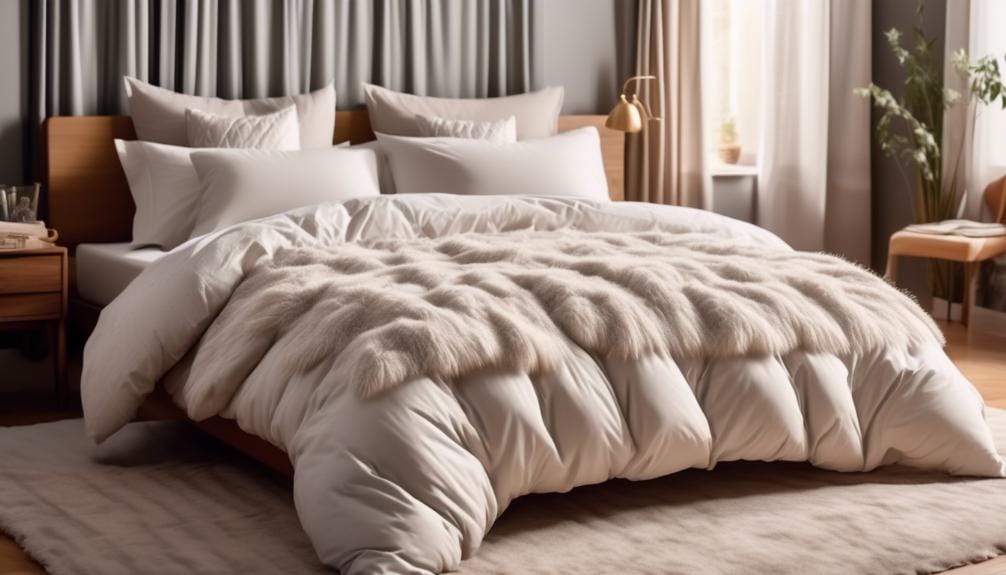Does a Duvet Need a Cover? Demystifying Bedding
You might think that a duvet cover is just an optional extra for your bedding, but the decision to use one can have a significant impact on both the functionality and appearance of your bed.
Many people are unsure whether a duvet needs a cover, and the answer isn’t necessarily straightforward. Understanding the benefits and drawbacks of using a duvet cover, as well as how it can affect the overall aesthetic of your bed, can help you make an informed decision about whether to invest in one.
Key Takeaways
- Duvet covers are essential for protecting duvets, extending their lifespan and keeping them safe from stains, tears, and damage.
- Duvet covers offer convenience and easy maintenance, as they can be easily removed and machine washed.
- Duvet covers allow for versatile bedroom decor, as they come in a wide range of designs and colors, allowing for easy customization of the bedroom.
- Duvets require covers and can be easily switched out by changing the cover, offering a cost-effective way to update bedroom decor without redecorating the entire room.
Understanding Duvet Covers

Duvet covers, designed to encase and protect duvets, provide an easy-to-maintain and versatile option for styling and caring for your bedding.
Unlike comforters, which are one-piece bed coverings filled with insulating material and can be used without a cover, duvets are soft, flat bags filled with down, feathers, or synthetic fibers.
The duvet cover acts as a protective layer for the duvet, preventing it from getting soiled and making it easier to clean. This means you can change the look of your bedding without having to replace the entire duvet, making it a cost-effective and practical choice.
Duvet covers also offer the advantage of being lightweight and customizable, allowing you to easily switch up your bedroom decor. Additionally, they come in a variety of materials such as organic cotton, offering a comfortable and eco-friendly option.
When selecting a duvet cover, consider the thread count, fabric quality, and whether it comes with matching shams to complete the look of your bed linens.
Pros and Cons of Duvet Covers
When considering the use of duvet covers, it’s important to weigh the practical benefits and potential drawbacks to make an informed decision for your bedding needs.
- Convenient Cleaning:
Duvet covers are convenient to clean, as they can be easily removed and machine washed, unlike traditional duvets which may require professional cleaning.
- Keep Warm:
Duvet covers offer the flexibility to adjust warmth by using different fillers, such as down or cotton, allowing you to customize your bedding based on seasonal needs.
- Versatile Styling:
Duvet covers provide an opportunity to change the look of your bed without redecorating the entire room, offering a cost-effective way to update your bedroom decor.
Duvet covers present a balance of advantages and disadvantages. While they offer convenience in cleaning and styling, they may require regular adjustment and the filling can clump up over time. Additionally, the cost of high-quality duvet covers can be a significant investment, but the versatility and customization they offer may outweigh the drawbacks for many individuals.
Duvet Vs. Comforter: Key Differences

Key differences between duvets and comforters are important to understand when choosing bedding for your home. Duvets are designed to be used with a cover, while comforters can be used as standalone bedding. The fill material also differs, with duvets typically filled with high-quality materials like down or feather, and comforters often made from synthetic materials like polyester. Another key difference is that duvets are generally more lightweight and easy to clean, as the cover can be washed separately, whereas comforters are often bulkier and may require special cleaning. Additionally, duvets can be easily switched out by changing the cover, allowing for a quick bedroom makeover, while comforters are a one-piece bedding option. The table below summarizes the key differences between duvets and comforters:
| Aspect | Duvet | Comforter |
|---|---|---|
| Cover | Required | Optional |
| Fill Material | High-quality (down, feather) | Synthetic (polyester) |
| Cleaning | Cover and insert can be washed separately | Often requires special cleaning |
| Versatility | Easily switched by changing the cover | One-piece bedding option |
Understanding these differences can help you make an informed decision when selecting the right bedding for your needs.
Benefits of Using a Duvet Cover

To fully appreciate the advantages of using a duvet cover, it’s essential to understand the practical benefits it offers for both bedding maintenance and bedroom decor. Here are the benefits of using a duvet cover:
- Protects Your Duvet: A duvet cover acts as a shield for your duvet, keeping it safe from stains, tears, and damage, ultimately extending its lifespan. This means you can keep your duvet looking and feeling fresh for longer periods.
- Easy to Clean: Duvet covers can be easily removed and washed separately, making cleaning a breeze. This not only maintains the cleanliness of your duvet but also allows for effortless upkeep of your bedding.
- Versatile Bedroom Decor: With a wide range of cover designs and colors available, using a duvet cover allows you to easily switch up the look of your bedroom. This versatility gives you the freedom to personalize your space according to your preferences and mood.
Using a duvet cover not only keeps your duvet in great condition but also provides convenience, customization, and additional comfort for a cozy and stylish bedroom.
Choosing the Right Bedding

After understanding the benefits of using a duvet cover, the next step is to consider the factors for choosing the right bedding that best suits your needs and preferences. When deciding between a duvet and a comforter, it’s essential to take into account factors such as maintenance, materials, and design versatility. Here’s a comparison to help you choose:
| Factor | Duvet | Comforter |
|---|---|---|
| Maintenance | Easy to clean as the cover can be washed separately | Often bulkier and more difficult to wash |
| Materials | Filled with high-quality materials like down or feather | Often made from synthetic materials like polyester |
| Design Versatility | Requires a cover and can be easily switched to change the look of the bedroom | Comes with its own cover, providing a convenient, all-in-one bedding solution |
Both options have their advantages, so consider your priorities when making a choice. Remember, the right bedding can significantly impact your quality of sleep. When in doubt, consult a bedding expert or the founder and CEO of a reputable bedding company for personalized advice on inserts and covers.
Frequently Asked Questions
Do You Have to Put a Cover on a Duvet?
Yes, you should always put a cover on a duvet. It protects the duvet, allows for easy cleaning, and offers versatile design options. Plus, you can wash the cover separately, making maintenance a breeze.
What Is the Point of a Duvet Cover?
A duvet cover serves as a protective layer for your duvet, preventing stains and tears. It also offers versatility, allowing you to easily change the look of your bed and provides additional warmth and comfort.
Is It Essential for the Duvet to Have an Inside Cover?
Yes, a duvet needs an inside cover. It helps to protect the duvet from dirt and oils, extends its lifespan, and can be easily removed for washing. Additionally, it allows you to change the look of your bedding.
Do I Need to Wash My Comforter if I Use a Duvet Cover?
If you use a duvet cover, you should still wash your comforter occasionally. While the cover provides protection, the comforter can still accumulate dust and odors over time. Regular washing maintains cleanliness and freshness.
Conclusion
In conclusion, while a duvet doesn’t necessarily need a cover, using one can provide numerous benefits.
Duvet covers protect the duvet from stains and wear, making it easier to clean and maintain.
They also allow for easy customization of bed and room decor.
Overall, using a duvet cover can enhance the functionality and aesthetic appeal of a duvet, making it a practical and stylish addition to any bedding ensemble.
